Text
[Review] Nickelodeon All-Star Brawl (PS5)

A strong—if barebones—platform fighter.
After Ludosity’s excellent and irreverent Smash-like platform fighter Slap City, Nickelodeon apparently asked them to make another using their cartoon properties. This would be a revamp of sorts for Nick’s long-running Super Brawl series of shallow browser- and phone-based fighters. Bringing on Costa Rican studio Fair Play Labs as co-developer, Ludosity turned out a solid contender in gameplay and polish, if not in features.

Like fellow Smash clone Brawlout, their focus seemed to be on honing the fundamentals rather than adding bells and whistles, but as a primarily solo player the perceived step down from Slap City’s robust story mode was a disappointment to me. I love this genre, but I need something to do that will encourage me to keep playing. The only option is Arcade mode, a straightforward series of randomly selected 1v1 fights at five difficulty levels. Completing this with a specific character unlocks some gallery images and a jukebox track, and that's about it. At least there are a decent selection of settings to customise matches, as well as the return of Slap City's ball-based mode for some variety.
The game was even more barebones at release, but postlaunch free updates added some big features like items (sadly, items do not spawn in Arcade mode) and full voiceover for all characters (many of which are the original VAs reprising their roles). Two extra characters were also added, as well as three DLC characters, all with accompanying stages. Not a bad record of support, although improving the single player experience was evidently a development opportunity for the sequel which I plan to play soon.
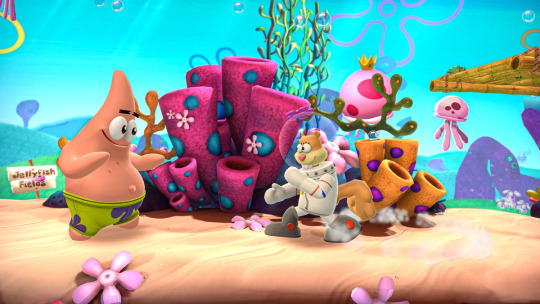
As a licenced game, NASB does a great job portraying its characters and locations. Compared to Slap City there's more detail to the art and animation and everyone looks great, which is an achievement when converting traditionally animated 2D designs into 3D (this can't be overstated, the game looks fantastic). The good-sized roster serves me well as a 90s kid with lots of classic Nicktoons along with other properties that Viacom has acquired (Garfield, TMNT), and even the few characters I don't really like or don't recognise have fun movesets. [Aside] I'm sorry but you could not pay me to be invested in the ninja turtles...! So I'm glad there's only two of them, avoiding the bloat that other Nick ensembles games suffer from by shoving all four of them in. Rant over.
The main reason I’m playing this now is as part of my current Avatar fixation, so having Toph in was a really cool choice alongside Aang and Korra, and their stages (the multi-level Western Air Temple, Omashu with its interesting layout and hazards, and Harmonic Convergence aka Final Destination) look amazing and have fun animated background details. Korra was my favourite, a straightforward heavy hitter with high-mobility specials.
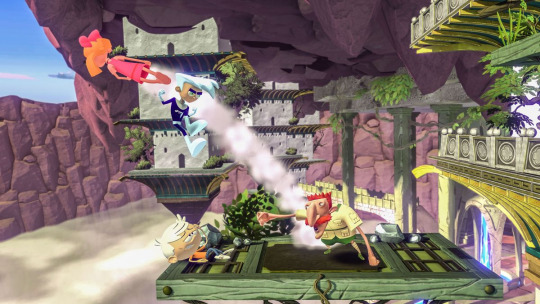
Which reminds me, I should talk about the gameplay. Like Slap City and Brawlout it’s streamlined a bit compared to Smash, but the way they’ve done it works well. The main difference is the removal of smash inputs and separate side attacks, with two distinct buttons for fast and strong attacks (both with aerial variants) in addition to specials. But they’ve kept guarding, grabs, and air dodging so it doesn’t feel too compromised. There seems to be a lot of depth with wavedashing and strafing and a paper-scissors-rock directional priority system if you want to get into it, but I think it still remains accessible. Maybe I can’t really judge that. What I will say is the basics are incredibly solid and polished, and I enjoyed playing around with different movesets. As always, it's fun to spot individual moves that are direct Smash lifts/homages as well as discovering the nuances of the new ideas.
Ludosity was a great choice to make a licenced game that's not crap, and Fair Play Labs appear to have ably assisted as well. They nailed the fundamentals of platform fighter gameplay as well as the authenticity and flat-out fun of seeing these characters in action (especially with the VO added in), making for a pleasing celebration of Nickelodeon's past. It's just such a shame that the game isn't more fully featured, which I assume was simply a time/budget reality. I guess that's what the sequel is for... I'll find out soon!
1 note
·
View note
Text
[Review] Avatar: The Last Airbender: Quest for Balance (PS5)
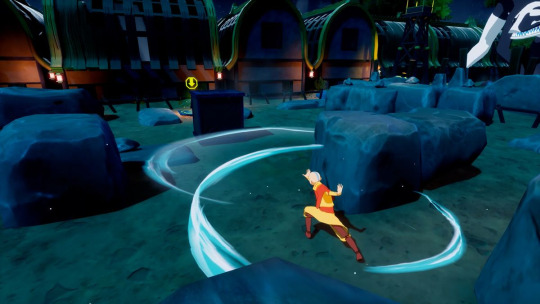
This show deserves better than this cheap and sloppy tie-in.
Peru-based studio Bamtang are the latest to be granted the Avatar licence, after making some decent kart racers for Nickelodeon. Quest for Balance is the result, and although it’s functional this revival game struggles to live up to the predominately Australian-made tie-in games that were contemporary with the show (and movie).
My expectations were quite high for this given the advances in technology since 2006-2010. But there are always other factors at play in game development, like budget, time, and the experience of the dev team, that are potentially lacking here. What I'm saying is the game feels cheap, from the bland level design to the simple combat to the abundance of rough edges.

Quest for Balance covers all three books of the original show... more or less. The six levels in each try to hit the major points while some episodes and events are skipped over; if you're lucky these will be summarised with a cutscene. But even the significant stuff is dealt with perfunctorily. I did like the side quests in the more hublike levels, with named NPCs and items to find that expand on the world a little bit, although it doesn’t amount to much.
The core gameplay isn’t too different from child/family games we have known such as the Traveller’s Tales Lego games. You explore a level, break objects and interact with interactables, get into fights, and solve some puzzles. Locking the fights into little battle arenas reminded me of the first two Avatar DS games, while the puzzles (maybe the strongest part of the game) recalled the third DS game. I still think I liked those better though.

These gameplay elements are often sectioned off, and the levels are mostly a flat and uninteresting sequence of rooms. There’s an inventory which I barely touched, and an upgrade system that incentivises finding goodies by improving your combat powers. I did get through most combat by just mashing with the most effective characters (Sokka and Toph as far as I could tell) but there is some depth when you’re not just getting stunlocked. Like most of the game it’s just let down by a pervasive clunkiness.
Co-op is available… most of the time. A fatal flaw is not letting a second player participate when the story requires a solo character’s involvement, as well as being unbalanced. That is, when the maximum three-character party is present, player 1 can swap between two of them while player two is locked to only one. These choices hamper its viability as a multiplayer experience (also, my spouse just thought the game in general was subpar and so left me to it).

I’d like to circle back to the cutscenes, as they represent the ramshackle feel of how the game is put together. A mere handful are in 3D, using the game models with some decent animation, which despite being prerendered can chug heavily when a lot of stuff is happening. Some are in 2D, going for a motion comic look but with distressing animated png warping. This includes a cute framing story where Iroh, Bumi, and Pakku are recounting the tale to a Ba Sing Se playwright. Others are brief in-engine dialogue scenes where the characters stand motionless. Or you might just have one of the aforementioned three recounters summarising exposition over a paragraph of text. Even with these various methods of varying levels of effort, they will at times neglect to properly set up the next gameplay portion. It’s frankly a mess.
I also have to mention the voice acting, which ranges from decent soundalike performances (eg. Katara or Toph) to… “an attempt was made”. As far as I can tell from a quick search of Behind the Voice Actors, the only VA that returned was Dee Bradley Baker for creature noises, and even his mastery in the field is undermined when you play one of the dull Appa autoscrolling segments and notice that they appear to have forgotten to apply any pitching down or treatment to his voice?? It sounds bizarre and unfinished. I do have to give the game credit for casting a higher proportion of actors of Asian descent though which is nice to see.
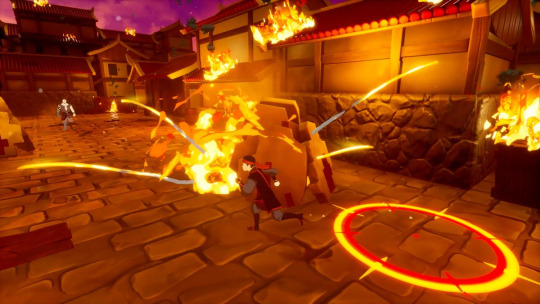
Let it be known that I 100%d Quest for Balance… minus some trophies like the one for completing boss battles hitless. In this janky combat engine and with the bosses as boring as they are, I couldn’t face it. But the game is just competent enough and revisiting stages is streamlined such that I didn’t mind going back for the side stuff, which is my favourite aspect anyway. On the whole though I can’t really recommend this game except to superfans; the old tie-ins are frankly of a higher standard and by virtue of having dedicated instalments for each season, do a better job covering the material on top of having more depth and variety. Plus the first one has an original story! This could have been a triumphant revisit of a beloved story, but it ended up a cheap cash-grab. Oh well.
#avatar#avatar the last airbender#avatar the last airbender quest for balance#bamtang games#review#ps5
2 notes
·
View notes
Text
[Review] Avatar The Last Airbender: Bobble Battles (PC)

A budget licensed RTS, it's about what you'd expect.
Frima Studio is a successful French Canadian developer: over the years they've done lots of casual, Flash, and mobile games, as well as some console stuff. I just found out they're working on a Risk of Rain spinoff currently. But one of their first jobs was making a tie-in Avatar strategy game in 2007, and they did it competently enough.
Based on Books 1 and 2 of the show, Bobble Battles takes its name from the "bobblehead" art style, better known as chibi or super deformed, which was employed in a few other spinoff projects like animated shorts, comics, and video games. It's an appealing look and helps a bit with readability of the characters when you're zoomed out (although character design could have differentiated common unit types a lot more), but you can't appreciate the look too well unless you're zoomed in, in which case the game is much less playable.
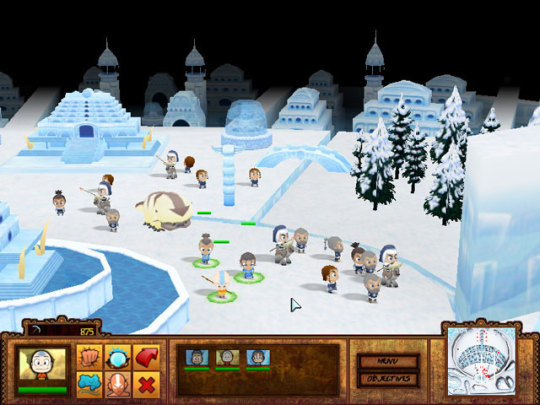
As a real-time strategy game in the vein of your Warcrafts and Dune 2s, it's been simplified and streamlined to the nth degree. There's only one resource, no upgrading, a handful of unit types that act identically between factions, and a basic control scheme. The limited nature of the controls hurt it as moving between the arrow keys to shift your view and the numbers for control groups is uncomfortable. Those are pretty much your only functions by the way; there's no attack-move or other specialised move commands, although hero units do have more flashy attacks.
I'm no RTS die-hard but even having played a bit of Starcraft and Age of Empires back in the day I couldn't help but find Bobble Battles wanting in gameplay. There's no rally points, few hotkeys, and just getting your units to do anything is a hassle. Selecting control groups instantly shifts the camera over to them, there's always a pause before they execute your commands, and they need to be heavily micromanaged to attack targets. Pathfinding in narrow spaces can be atrocious, with your guys often milling around or getting stuck on walls when you're on a city-based level. On the whole there's a lot of pain points in the micro scale, and little need for macromanagement at all. I understand the desire to create a game in this genre for younger audiences, but it's not just dumbed down, it feels shonky and shallow.

The game is structured in three campaigns. The first two more or less cover the heroes' journey through the first two seasons of the show, while the third has you playing as the Fire Nation trying to stop them. After completing these you unlock the Timeline mode, which rearranges the scenarios into chronological order... this seems superfluous. The missions do try to have some variety between small-scale hero exploration and production maps and to give you different kinds of objectives. They do a decent job at this, although the scope never gets very big. The most that will ever be demanded of you is juggling three control groups to defend three settlements that are pretty close together, but again this is baby's first RTS so I don't knock it for lacking difficulty.
As an Avatar game, it's kind of cool seeing events from the show reinterpreted into a new genre. You rarely had squads of people running around battling in the series, so there's some novelty to that. The characters having unique abilities is fun, and I got a kick out of seeing the designs of building and units between the nations. There's even one unique creature here, the goat-like mount that Water Tribe riders use. [EDIT: This beast does actually appear briefly in the North Pole episodes.] Only covering two-thirds of the show is a bit of a letdown, although to be fair it's an unavoidable consequence of the passage of time and when the game was commissioned. Can't argue with the immutable laws of time and space.

Bobble Battles is essentially fine. It works. There's even some creativity in how it's interpreting the source material and in the scenarios, but by attempting to simplify what is generally a complex genre, I think they went too far and actually hurt the playability. And that's before mentioning the dodgy behaviour of your units. It gets points for its uniqueness within the sphere of Avatar games, but it's hard to recommend except for completionists like me, and they would just play it anyway so it doesn't matter what I say about it!
2 notes
·
View notes
Text
[Review] Toren (PS4)

A flawed but interesting Ico-like.
Swordtales was an indie studio in Brazil, staffed by many first-timers in commercial game development (or at least their Mobygames profiles mostly don't have any other games on file to their names). They seem to have gone defunct, another casualty of the cutthroat video games industry. But before they dissolved, they managed to put out a short Ico-like adventure which, while rough around the edges, has some neat ideas and imagery.

The story of Toren is hard to explain... it's conveyed piecemeal and out of order, via digressions and abstractions. But you eventually glean that human hubris built a tower that challenged the heavens—sound familiar?—to which the Sun (yes, that Sun) took great umbrage, and now the flow of time has stopped. To avert catastrophe and restore the natural order, a girl was granted the hopes of humanity to ascend the tower and something something the moon, and there's a dragon, plus a legendary warrior is involved somehow...
The real central idea of the game is that Moonchild is locked in a cycle of rebirth: aging, dying, and coming back as a baby born from blood, repeatedly fighting the dragon but never victorious. She starts in the prologue a grizzled warrior, before coming back a toddler. As you progress you will age from child to youth to adult, her character design getting cool flourishes each time (check out Pedro Jatobá's ArtStation for a better look at these than the game itself offers). It's like Jaleco's arcade game Momoko 120% but instead of a gun you have a sword.
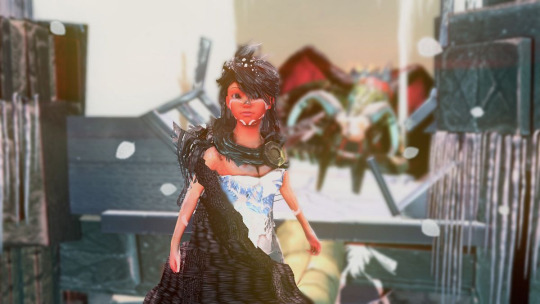
The idea of resurrection is used in a clever way a couple of times, where the dragon petrifies Moonchild's body, then you respawn but your previous stone form remains, letting you progress somehow. I wish this had been explored further as it's an excellent idea that's just underutilised. Otherwise progression is via little puzzle sections where you have to approach the dragon past its buffeting winds and magic shockwaves, or you're ascending the tower by growing a tree, lighting braziers, or other interactions. Small enemy blobs with teeth sometimes get in your way but they're not a serious hindrance.
You also sometimes go into dream sequences, and Moonchild's inner world opens things up for some more surreal imagery. It doesn't get too wild but it's a nice change of pace, and usually involves a new kind of puzzle where you draw patterns with salt. None of the puzzles are very taxing at all, in fact the whole game is quite gentle but that can be a nice thing. Some of these dream zones (and a couple of unlockable bits of gear) are missable, so maybe check a guide... or play the whole game twice, like I did! With the themes of reincarnation and cyclical time, it seemed appropriate and I got a better grasp of the whole thing that way. It's short enough that I in fact wasn't completely satisfied until having done a second run.
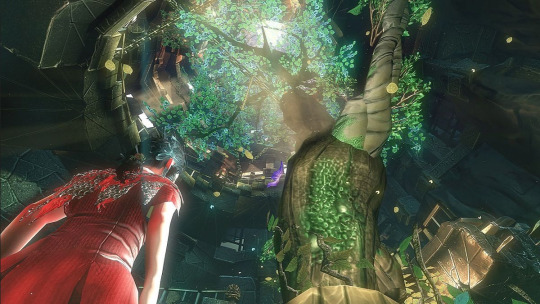
I really must address some rough spots here. The first thing you'll notice is the game's look, which resembles a very early PS3 game with its shoddy textures and performance, coupled with a sort of blurry wobble effect to the lighting, especially in the dreams. The technical shortcomings do a disservice to the art design, so it ends up not totally delivering on its promise, and it is promising! The play control and animations are also stiff and awkward, so on top of unchallenging puzzles and simplistic platforming the gameplay is just not as special as it should have been.
It's unfortunate that the strengths of the concept were let down by these other factors. But hey, it's short and cheap so it's easy to take a punt on it... although I don't know where your money would go, what with the developer defunct and the publisher also defunct after being acquired by Tinybuild then jerked around, leading to a legal battle. Video games, am I right? Anyway, the strengths are still there in some form and manage to shine through at times... there's something there, and I'm glad I got to see it.
2 notes
·
View notes
Text
[Review] Rime (PS4)
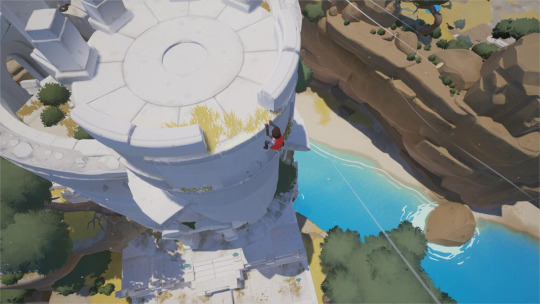
Another Ico-like adventure.
Another Ico-esque title on my backlog is this 2017 game by Spanish studio Tequila Works. They have had success with a variety of genres and tones, but in this case the Mediterranean-inspired setting and vibrant colour palette give this game a nice flavour. Otherwise it's a solid platform-puzzling adventure with a decent story, even if there's something of a double-take at the end.
I'll deal with the story first since it involves a bit of a content warning (child death) in addition to a spoiler warning. You see, you think you're adventuring around a mysterious island as a "ye olde times" lost princeling, exploring ruins, fending off shadow creatures, befriending fox spirits and ancient robots, and ascending a monolithic tower... until an epilogue reveals that it was all some kind of fantasy of a modern grieving father. This wholesale reframing is interesting structurally, and I liked the idea that each chapter corresponded tonally with Kübler-Ross's stages of grief, but with how late and sudden this element is introduced and how confronting the subject matter, it came as something of an unpleasant shock for me personally.
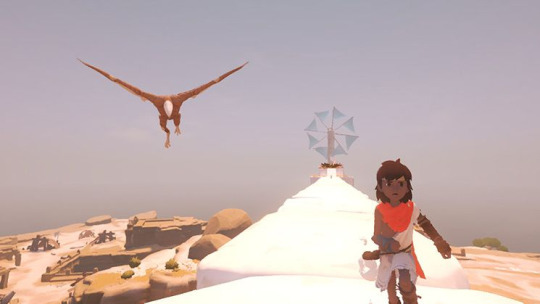
There are collectibles to find in hidden dead-ends or secret coves that tie into the fictional backstory of the prince, but I don't think anything really hints at the real surprise. So for most of the runtime you're just having a gentle fantasy adventure. The shadow creatures are creepy but don't pose much of a threat, and chapter 2 has a creepy reptilian bird monster that you have to hide from, but otherwise it's a nice conflict-light time.
Each chapter runs through a few puzzle ideas: shifting light and shadow, perspective, moving orbs around, things like this. The child (who I think is named as Enu in the credits) can clamber around, move boxes and such, but their main method of interaction is a quick shout which can activate magic statues as well as inflame braziers and oddly break pots (there are trophies for doing these a certain number of times). The puzzles are rarely challenging but can be decently clever and the game keeps up the variety through its five-odd hour runtime.

I don't have much more to say about Rime but I did enjoy my time with it quite a bit. It's well-made, the environments and atmosphere are nice... it was a good chill-out game. It's clearly trying hard to say something with its story which I respect, even if it didn't quite land with me at the time. But damn if I didn't love shouting at every wall-mounted torch in a hallway on my way to the next bit.
2 notes
·
View notes
Text
[Review] Vane (PS4)
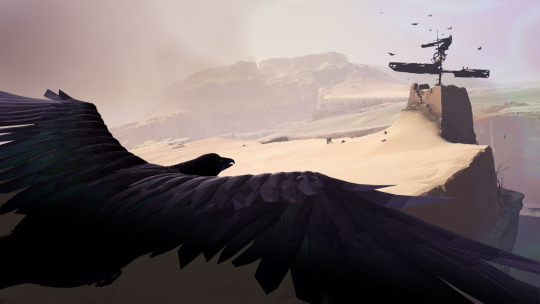
You're so Vane, you probably think this game is about you.
During The Last Guardian’s long periods of development hell, some staff left Team Ico entirely. Two individuals gathered with other developers, fellow foreigners working in Tokyo, who were tired of working in huge studios and wanted to create more personal projects. They were Friend & Foe Games… now with their website lapsed and social media feeds silent since 2019, I have to assume the studio has dissolved. But their legacy will be the unique and fascinating game Vane.
Calling Vane Ico-inspired doesn’t do it justice but there are some similarities: you spend a good chunk of the game as a child realistically navigating an enigmatic world and solving environmental puzzles. Only, the child is actually a bird. An interesting thing about Vane is that promotional materials only show about half the game, and it takes some turns as it goes on which I will spoil below, simply because the game reviewed poorly and doesn’t seem to get much attention, and maybe revealing more will entice some people to try it. Who knows.

There are four phases to Vane. The first has you flying around an open world as a crow-like bird. The game gives very little explicit story or direction to the player, aside from occasional control prompts (much less intrusive than TLG’s frequent tooltips, I might add). Figuring out what to do feels nice as you experiment with the flight movement, gather a flock of birds, and release a golden orb from a ruin. The golden matter exudes floating triangles and contact with it transforms you into a childlike humanoid, while warping the landscape around it.
The warping and time-reversing effects of this matter play into a lot of puzzles going forward and are one of the coolest ideas the games has, but for now it serves to change your state. The accompanying graphical and technical effects are incredible though, as the geometry dynamically reshapes itself. It also exhibits stop-motion-like lowered framerate which effectively conveys the otherworldly quality of this technology. In other ways the game has visible polygons and limited colour palettes that make for a compelling and abstract atmosphere.
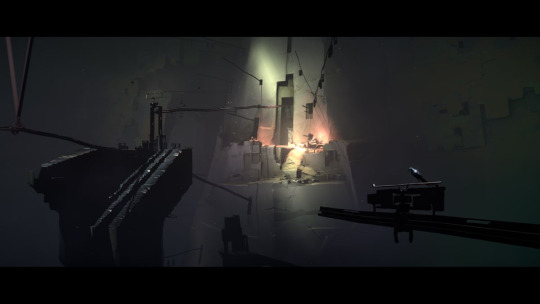
The second phase plays with the transformation mechanic. In large underground caves amid wrecked mechanisms you will free other birds/children from imprisonment while swapping between the forms: the bird can fly and perch, while the child can push and pull things to progress. These chambers are large with multiple objectives but from here on the game becomes more linear in its structure. I wish this phase went on longer and indeed a Dualshockers interview with one of the devs outlines cut content that seems like it would have fit in this phase, but the game has more ideas it wants to try out and new settings to move the story on to, so it’s probably for the best for pacing reasons in this relatively short experience.
The third phase involves a massive timeshift, reverting the state of the world from the bleak wasteland to a metallic tower complex in the midst of a cataclysmic storm, which is also the context of a brief prologue sequence. At this point the bird form serves merely as a tool for scouting, with the bulk of this chapter seeing the child rolling around a large golden orb with the help of other kids. The orb has an effect similar to Zelda Skyward Sword’s timeshift stone boat, but more involved as it dynamically repairs parts of the damaged complex to allow you access. I got a bit lost a few times here but the game teaches you enough that with some experimentation it’s satisfying to solve, and ultimately you arrive within the tower itself…
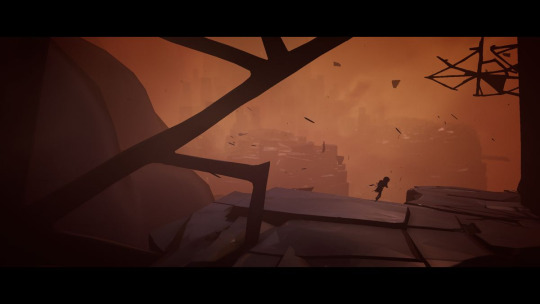
The fourth phase continues the theme of reshaping the world with the power of sound: before, shouting at the orb would extend its range but now you have access to a gold birdlike mask that can itself create paths through a surreal twisting interior space. The bird form is now inaccessible and the game narrows its traversable space in this phase but it’s in service of the story, depicting your final transformation. Ascending the tower sees the mask bond to you and after a memorable sequence of the ground chaotically forming paths and staircases in a void (a fantastic effect even if I fell through the floor a few times) you yourself become one of the ominous tall masked figures whose presence have loomed over proceedings through the previous phases.
A final choice closes the loop as the world dissolves into its phase 1 state and you ponder what it all means, and then you can start all over again (or choose from any of the phases). I did and had a great time hunting my missing achievements, including exploring an optional Ico-like area in phase 1.
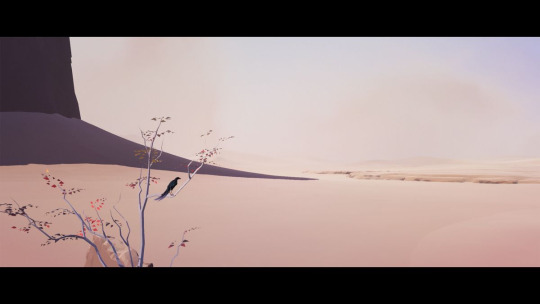
Thank you for indulging this more thorough than usual dive into the game’s events. I just thought that the different phases are so distinct that it was worth getting into how they play out. Vane is such a memorable experience, with so many great moments in its short runtime. The tone and look are incredible, and while I understand the choice of a sparse soundscape I wish it was more full of the hard techno that comes in sometimes. Maybe the crunch-heavy work environment described in the Dualshockers article was not the most healthy way to develop a game over five years, but it certainly resulted in an experience I'll be thinking about for a while.
2 notes
·
View notes
Text
[Review] The Last Guardian (PS4)
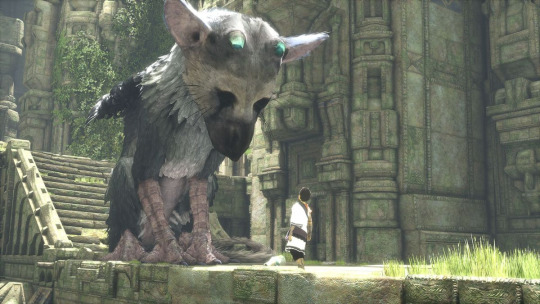
Ico 2 & the Colossus.
The Last Guardian (bad name) had a messy development, with Team Ico working on the game since 2007. Struggles with the PS3 prolonged its gestation, and Team Ico disbanding and leaving Sony can't have helped. But Director Fumito Ueda formed a new studio, GenDesign, with many of the former staff, and they decided to continue collaborating with internal Sony studios to finally get the game finished in 2016.
I feel like knowing this game was in development hell for almost a decade helps me understand some things about the final product. The movement and mechanics have the same kind of clumsy jank that Ico and Shadow of the Colossus do, but somehow it doesn't hang together as well. The big new gameplay ideas end up in player frustration way too often. The overall story is full of enticing mystery but leaves off with too many lingering questions.
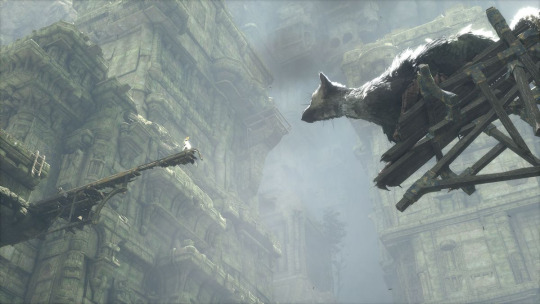
Describing the game as Ico 2 fits it well, I think. You're a little boy (unfortunately nameless this time) clambering around an old mysterious ruined castle solving puzzles to proceed through the environment, and avoiding capture by . This time instead of an enigmatic girl as your companion (or a horse, in SotC's case) you have a gryphon-like creature named Trico. A more apt comparison might be the Anzû of Mesopotamian mythology, as there's other inspirations from that culture in the looks and plot (thanks to my friend Gibbon for pointing this out). Sidenote, Trico is usually referred to with male pronouns, which breaks the pattern of male protagonist and female companion in the previous games. And yes, I feel like constant comparisons are warranted with this series since there's a fairly distinct throughline.
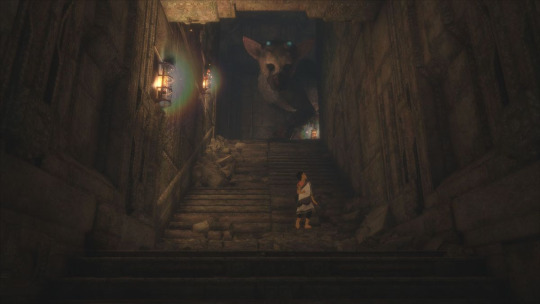
Anyway. The Ico continuity is clear, while Trico represents a kind of friendly Colossus, as you often have to climb on them... and try to manipulate their wilful behaviour the way you had to in some Colossus fights. A key technical goal and talking point of the game is Trico’s realistic animal behaviour… well and good but having a character you rely upon be consistently recalcitrant and obtuse did not make for a consistently enjoyable gameplay experience for me. You soon learn to issue commands to Trico and while it can be thrilling to ride them around and fight alongside them, the delays and misinterpretations really added up to frustration for me more often than I’d like. Add to this that it’s not always clear what you have to do next, and that progress sometimes looks like failure in this linear story-driven game, the result can be confusion.
The dynamic between the two is the heart and soul of the game, so when it breaks down you can feel helpless. But when it works it’s incredible, this big feathery kitty coming to trust you and helping you solve puzzles, while you work to heal Trico’s hurts and traumas. This is a really strong concept that the whole game is built around, it’s only let down by some clumsiness in the execution.
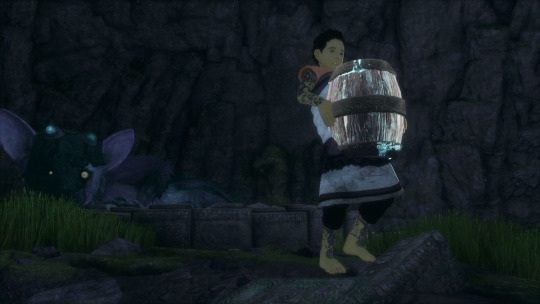
As you venture around these crumbling chambers and towers, there are a few optional things to find. Trico is fed via glowing barrel; they attract glowing butterflies of the same colour so I figured that’s what they contain but the truth may be more sinister. Finding out-of-the-way rooms with barrels adds up to costume unlocks… a limited form of cosmetic customisation that sadly is only enabled for subsequent playthroughs. Unless you’re planning on multiple runs, you’ll have to settle for finding them being its own reward. Especially when you can’t get Trico to eat the damn things, or your discovery of them gets reset when you die on a platforming section.
The Last Guardian (still a bad name) is an uncut gem, it could have been so brilliant if not for the roughness that pervades the experience. As with its two predecessors it has strong art direction, the ancient land you find yourself in the perfect place for an adventure full of mystery. But with as many cool and interesting ingredients as there are, there's aspects that are clearly not ready for primetime even after so long in the oven (to mix a metaphor). Even things like Trico's appearance I feel are representative of the game as a whole: they worked hard to give each feather individual rendering and physics, but look at it as a whole and it's a big flapping mess. Eight years on, TLG doesn't seem to have had the impact and staying power as Team Ico's other games have, and that's a shame... but I understand why.
10 notes
·
View notes
Text
[Review] Shadow of the Colossus (PS4)

A PS2 classic, but now it looks prettier.
I first played Shadow of the Colossus nine years ago... hey wait, this year is this blog's tenth anniversary! Wow! Anyway, I played the 2011 HD remaster on PS3 at that time, which was done by Bluepoint. Seven years later they had another crack, this time doing a full remake which goes further in modernising this classic without changing it too much.
Ever since I learned about all the cut content from the seminal PS2 game I hoped that maybe some new colossi would be added to this remake based on the concepts. Bluepoint's approach seems more concerned with faithfully recreating the gameplay, with their main addition being new hidden collectibles that recall old community secret-hunting. They seem to have taken to this project with a lot of care and respect, which I have to in turn respect myself, even if I personally wanted more of a shakeup.
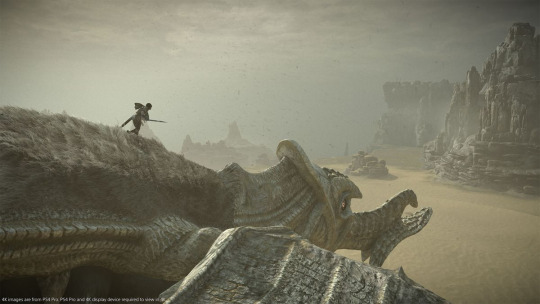
Team Ico's 2005 game is a classic for a reason, and its stark world and cool ideas for fighting giants still hold up. The latter is untouched here, complete with the still-impressive scale, the often janky jumping and clambering, and the colossi whose fights vary from exhilarating to tedious (to paraphrase 2015 me). On balance there's more great moments than there are rough spots, but those moments of friction can be painful.
As for the world and the art design, this is the biggest change in this version. Recreating all the assets gave Bluepoint the opportunity to add a lot more detail to the environments, which depending on who you ask may detract from the atmosphere of the original. For my part I love the new vibrancy to the world, not to mention the elimination of fog, pop-in, and the excessive bloom lighting effects. This forbidden land retains its desolate beauty, only… I can see it better now. Performance Mode's smooth 60 fps framerate (on PS4 Pro or PS5) is the next-gen cherry on top; switching to Cinematic Mode was hard on the eyes in comparison.
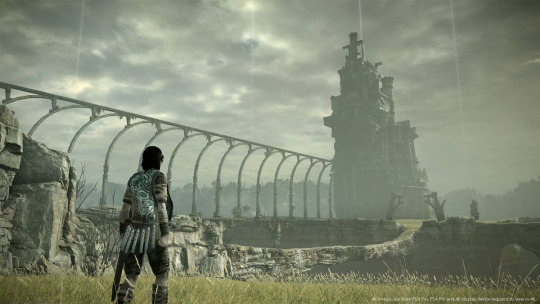
I enjoyed revisiting this world, and the boss fights. Hunting for lizards in the open world is a nice breather (although changing the HUD to no longer have a giant grip circle is one minor nitpick I have with this remake). All the original's secrets and unlocks are back with a few new extras, but... while these bonus modes and things are great for people who really love the game, I merely "really like" it, and couldn't face spending 45 minutes on that final boss multiple more times for some bonuses that aren't even usable in Time Attack itself. I did two fights in this time-pressure mode but adding this limit only resulted in frustration for me, not fun.
The new 79 enlightenment coins are also a nice extra that motivate you to thoroughly explore the game world's nooks and crannies, but there's no in-game checklist and getting them all apparently requires hard mode Time Attack near-completion. It seemed daunting to the point of exhaustion for me and I decided my time with the game was once again at an end. I have more Team Ico and related games that are new to me that I'm keen to move on to!
4 notes
·
View notes
Text
[Review] Sephonie (PS5)

Analgesic does it again with this puzzle-platformer/puzzle stunner.
After Anodyne 2, Melos and Marina of Analgesic created this game, which is in many ways an evolution of the exploration of 3D spaces seen there. In other ways it examines similar themes to All Our Asias and Even the Ocean, so I'm glad I played those first. There's plenty of innovation here though with a new PS2-esque art style, an interesting movement system, and the integration of tile puzzle sequences. Basically, there's a lot of cool stuff going on here, with the typical Analgesic layer of raw humanity underlying everything.
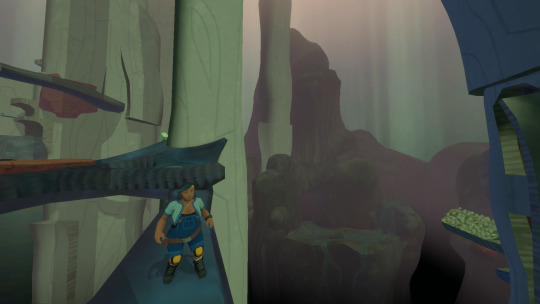
There's an issue to address up front: do not play the Playstation release. Sephonie has three main characters, all of Taiwanese descent. The game goes into their backstories which are wrapped up in connections between Taiwan, Japan, and the USA (reflecting Melos's own background and to a lesser extent Marina's). The idea of Taiwan and cultural heritage is vital to the story, and is in fact one of the stated purposes of the game by its developers: to bring attention to a culture that is sorely under-represented in media, especially video games. Part of the reason for this is active suppression by the Chinese government, which Sony is party to via a prohibition on even mentioning its existence. The result is a censoring of all mentions of Taiwan in the PS4/5 versions, replacing it with "Atlantis" (and Taipei with Timaeus, and so on) which as Melos noted on the Analgesic Discord "seemed like an absurdly appropriate way to do it because those sorts of censorship laws effectively want Taiwan to become an imaginary place". Needless to say learning about this seriously bummed me out, and while the story is mostly intact, I'd recommend checking this out on other platforms.
With that out of the way... the game opens with a shipwreck on the isolated Sephonie Island. Three scientists set out to explore this mysterious place with the help of the sci-fi Onyx technology which lets them wallrun and airdash, as well as letting them communicate with the unique flora and fauna. As you explore the caves beneath the surface, things get more surreal and the stakes are raised as it's revealed the island is sentient and is hiding a deadly secret... which makes things sound sinister but most of the interactions you have are quite gentle and wholesome, with themes of connection and interdependence.

The three characters play identically but have their own personalities which are expressed a number of ways. Collectible items hold details simultaneously mundane and essential about their daily lives and memories, while climactic cutscenes cover deeper dives into their histories, their thoughts and hopes and joys and cares. Later areas also begin to be influenced by the characters, the cave system contorting itself to match moments and places from their lives, complete with ephemeral NPCs you can talk to. As with Analgesic's other games, the writing consistently has a sincerity to it that really cuts through, and compels you to care, to think, and to reflect.
Between these moments are some cool platforming mechanics, with a run button taking you into something akin to skateboarding movement. Mastering the wallrun and the mid-air hop from dashing into a wall are satisfying, and there's plenty of new gimmicks that get introduced as you go to add new twists to it. The postgame unlocks the "Bubble Adventure" mode that adds bubbles to each zone, acting both as shortcuts and a new challenge to pop them while returning to safe footing, which was a lot of fun as a way to engage further with the movement systems (after ten hours doing the base game, I spent another ten doing Bubble Adventure and finding collectibles and out-of-bounds secrets!). But if they give you trouble, there's plenty of accessibility options to customise.

While exploring you find new forms of life, with some cool and slightly otherworldly designs. Interacting with them leads to the recurring puzzle minigame, where you place blocks in a grid to create large matched colour sets. I enjoyed these as a change of pace, but most can be skipped if you don't get on with them. Your reward is some info about the particular fauna or flora's ecological niche which seems well-researched, as well as some amusing dialogue with the creature itself.
In addition to Bubble Adventure, completing the game gets you a nice plot epilogue that provides a satisfying cap to the story, as well as some behind-the-scenes looks at the game's development which are now customary for Analgesic. Popping more bubbles opens up playable early draft levels as well as debug and test rooms. This kind of candid archiving really deepens my holistic engagement with their games, and in this case reveals that most of their best ideas did indeed end up in the game... although I wonder if the hoverboard concept could have been cool!

There's a lot of admirable stuff about Sephonie, and it's a great addition to the overall Analgesic catalogue. I feel like each new game they put out only enriches the others. Once again the result is a really special experience, and one that I'll remember fondly, even with the bitter edge of the cultural censorship that mars the Sony versions. I can't wait to see what they do next! (It's called Angeline Era, wishlist it on Steam I guess?)
2 notes
·
View notes
Text
[Review] All Our Asias (PC)

Another thought-provoking combination of retro-style graphics and emotional sincerity!
Between Even the Ocean and Anodyne 2, Melos Han-Tani (one half of Analgesic Productions) created this short adventure game. Well, Marina Kittaka (the other half) made some contributions along with others but All Our Asias is mostly a one-person project and a personal story-driven experience.
The game is a meditation on various topics. What does it mean to be Asian? How well can you really know another person? What kind of impact do you want to leave on the world? Through Yuito’s quest to discover more about his estranged father his own motivations and identities are challenged, and by extension the player’s. He struggles against bureaucracy, finds truths mundane and profound, and encounters compassion and community. There’s a lot going on in the game’s 90-120 minute runtime.

All this is wrapped in an exploration of low-poly 3D spaces that feel very much like Anodyne 2’s 3D overworld. The trademark Analgesic melancholy is here in spades accompanied by a familiarly haunting soundscape. The environments are abstract, built from the dreams of a dying man of real places and memories, made surreal and twisted. Trundling around them is slow, which gives you time for the atmosphere to wash over you. They may just feel like a vehicle for the story at times but they’re still very evocative in their own right even if the “gameplay” of navigating them is relatively shallow.

Like other Analgesic games, there is naturally a postgame. Infinite flight is unlocked along with warps to the different game sections. Developer commentary and behind the scenes material is however relegated to a separate book which can be purchased in a “fan pack” along with the soundtrack. The game itself is free so it’s a good way to support Melos and get more out of this piece.
Since it is free, there’s little barrier to trying it out… I did have to set up a Joy2key profile since it failed to natively recognise my controller, but it was worth it. The low-poly stuff is a good way to get you in the door and then you just might find that the game makes you think about things a bit! We need more of that in our games, I reckon.
1 note
·
View note
Text
[Review] Even the Ocean (PS4)

A unique and soulful puzzle-platformer.
Anodyne 1 and 2 are really special games, so it's past time for me to catch up on the rest of the Analgesic catalogue from Melos Han-Tani and Marina Kittaka. This is their second game together, and takes on the puzzle-platformer genre but with a heavy emphasis on story.
Compared to the Anodyne games, the themes are a little more straightforward and the world more grounded than their abstract dreamlike spaces. The story deals with environmental and social issues, but with strong characters who feel very human and real through their dialogue. The story opens with the death of a minor character, but rather than exploiting it for dramatic stakes and moving on, the entire rest of the game sees you forming a friendship with her grieving partner, discussing deep topics with her and so on. As the game goes on and the stakes are further raised, it still takes the time for smaller moments and well-drawn minor characters.
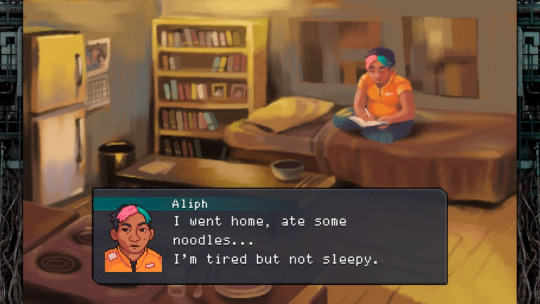
This emotional content and social commentary is the strongest part of the game, not to say that the gameplay parts aren't also good. But the puzzle platforming can feel isolated or distinct from these aspects. The mechanics of it do tie into the worldbuilding which is linked to the themes though. In this sci-fi fantasy world, the main governing principle is the two energy types: light/green/vertical, and dark/purple/horizontal. Everything is built around this central idea.
Our protagonist Aliph has to balance the two energy types while blocking with a directional shield. She has a personal energy bar and when interacting with objects and obstacles this shifts between the two extremes. Charge yourself with dark and you walk faster, with light and you jump higher. But rather than a traditional health system, if you fill up completely on one or the other you die. Basically all interactable elements are aligned with either energy, and this leads to all sorts of clever puzzles along with the balancing act of managing your own tendency.

Progression through the puzzle spaces is mostly linear and I didn't find it very challenging for most of the runtime. There is a lot of customisation though, and you can choose if you want to just play the action parts or the story parts, as well as gameplay modifications to make it more manageable if you're having trouble. This makes the game very accessible, although oddly there is no option for button reassignment.
As I've come to expect with Analgesic games, there is also an extensive postgame although Even the Ocean takes it to extremes I haven't yet seen in their catalogue. You get new options to zoom around, warp, and display minimaps but most of all you get an entire new game world consisting of rough drafts and earlier versions of levels filled with developer commentary. This really opens the door on the development of the game and is really interesting from an archival perspective, having this behind the scenes content in playable form within the game itself. You get to see assets from when all the environment pixel art was made by hand (the final game uses art from larger images outside of the "dungeon" areas), as well as much more complex and difficult level design ideas.

These in-depth offerings are such a fascinating look at what the game could have been that I couldn't help but wish that some of it had made it to the final product, that we had more polished forms of these more challenging puzzles. On the other hand, the choices made to simplify the art production process I thought resulted in a fantastic end product, the interesting character designs coming through well in pixel form against the beautiful and moody backdrops.

Either way, these extras are remarkable, a candid conversation with the player on how the game was shaped and when you are directly told the rationales it's hard to argue that Melos and Marina made the right decisions to make the game memorable and accessible, and the game as a whole is much stronger and more interesting for having them. Please spend some time exploring the postgame if you give this a go! Anyway, although I have quibbles with the slow difficulty curve and the sometimes awkward menus, Even the Ocean ended up being another unique offering from Analgesic, packed full of ideas and heart.
11 notes
·
View notes
Text
[Review] Lunistice (NS)

The more throwback 3D platformers the merrier!
Lunistice is a retro-style 3D platformer mostly made by one person, Dennis Kröner. It was supposed to be a 30-day development project but in reality it ended up taking more than a year! The inspiration is 32-bit titles on the PSX and Saturn, so environments are blocky and textures low res, but without the warping or low frame rates that plagued these kinds of games.
The gameplay also feels modern and smooth while evoking retro level design. In many ways it’s very similar to Siactro’s Toree games (and in fact Toree herself appears as a guest character!) with linear obstacle course-type levels, but with plenty of twists and turns (and checkpoints, thankfully), not to mention short looping branching paths for extra collectibles. You have a double jump plus an attack that works as an extra mini-jump, and there’s otherwise plenty of bouncing and other little interaction gimmicks to keep the pace flowing. Lovely stuff.

Our protagonist Hana is an anthropomorphic tanuki—or maybe a comatose human undertaking a sci-fi special ops mission—and much of the iconography of the colourful worlds of the abstract dreamscape she’s jumping and grinding through is Japanese tinged. Get the main bonus items in a level and you can unlock a bit of lore about the high concept scenario, but it feels a bit disconnected and ultimately unnecessary.
With about a dozen levels the game is a great length for an indie snack of this sort, although individual levels are pretty substantial. After beating the game Toree becomes available along with Toukie, a samurai bird character from the early access 3D roguelike Holomento. These two have different attributes that make playing through again a satisfying prospect. Their collectibles get swapped out for ones appropriate to their sources, but otherwise the levels are the same.

Complete the game with them though and they each have their own authentic final stage… well, I haven’t played Holomento but Toree’s level feels like a Toree level! Toukie’s stage is a nice change of pace, a sprawling map more like a collectathon exploration platformer. They’re a great addition to what is otherwise a neat little package.
Lunistice is an utterly charming throwback that knows when to add modern touches for a perfect blend. If you are a fan of Siactro’s games like I am, especially the many excellent Toree games, well this is right in that wheelhouse albeit a little more complex and challenging at times, perhaps. I had a lovely time.
2 notes
·
View notes
Text
[Review] Shu (PSVita)
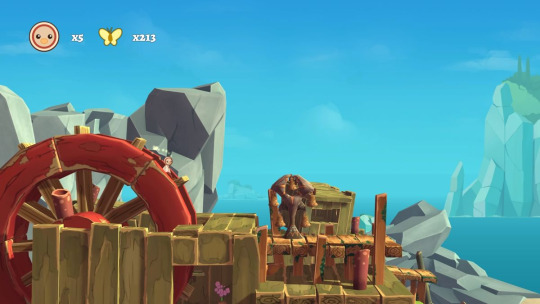
This platformer is a right charmer.
Still working through my library of Vita-compatible PSN games, Shu is one of those games that just caught my eye while browsing the sales page one day. A relatively early release from British indie studio Coatsink, the trailer gave me some Rayman Origins vibes which was enough to hook me instantly. The game itself is not quite as ambitious as that but was enough to delight me for a few hours.
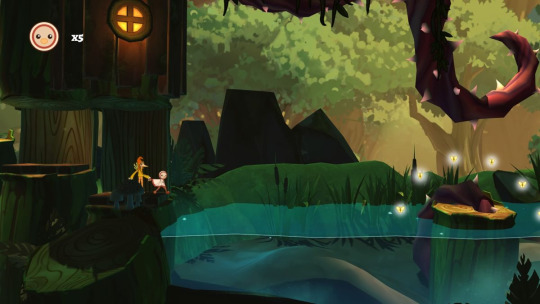
While the inspiration seemed obvious to me, the gameplay is a little more minimalist than the new Rayman games. Your main actions are just to move, jump, and glide, without much momentum management. There is the brilliant companion feature though, where Shu's fellow villagers pop up to help him out. Each world features two who will run alongside you holding hands (so cute!) and grant you a new ability, be it a double jump, water running, wall jump, a dash, or some other interaction with a level gimmick. This culminates in the final gauntlet level that cycles you through all of them in a row.

Although the game features "only" 15 levels, each one is packed with obstacles and collectibles. There's no combat or boss fights, but you do sometimes have to run from a sentient storm and its gaping mouth, which can get pretty tense. Unfortunately they did implement a lives system (not having taken on board the freedom of Rayman Origins' removal of this mechanic), but it actually works like Little Big Planet: each checkpoint tops you up to five lives, with no other way to increase your total. The game doesn't need lives, but it was interesting since I haven't seen anyone else use the particular system LBP did.
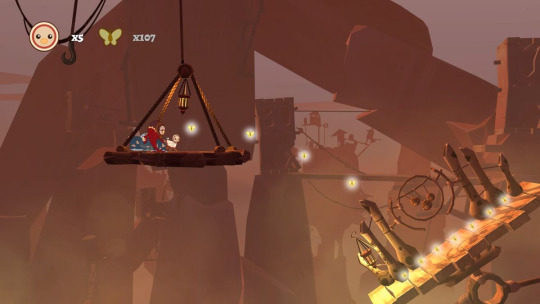
With its stylised hand-drawn characters on top of lovely 3D environments, Shu makes a strong impression. The character designs in particular are just so charming. I was glad there was a hub level that lets you try out their abilities and view some concept art for each. The game is also good about communicating gameplay notions visually which is important in the chase scenes or time trials.
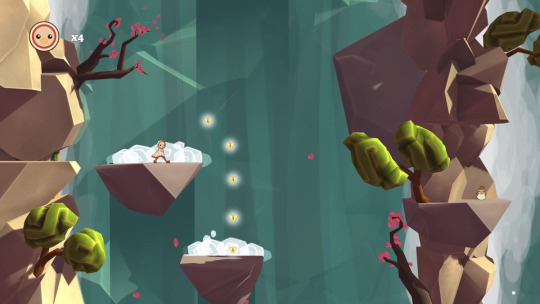
Shu is just a pleasant time all the way through, with only a few pain points in certain later levels. The different worlds have distinct styles and the companion characters help change up the gameplay too, with nothing overstaying its welcome. The field of view is just right, although playing on the Vita the characters and interactables seem tiny... but I actually like that a lot as a style! I'm glad I took a chance on Shu because it charmed the trousers off me; spiffing.
1 note
·
View note
Text
[Review] Pic-a-Pix Classic (PSVita)
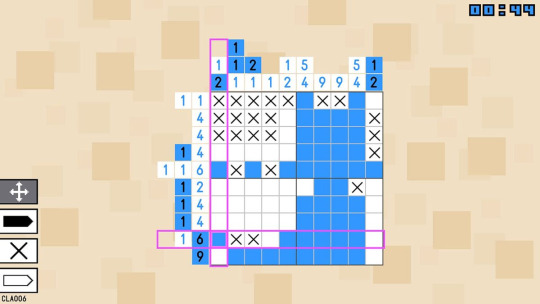
A pleasant pixel puzzler.
I'm still recovering from Covid and need rest. One of the best ways to get me to sit still for extended periods of time is to give me a nice Picross game to play; I simply can't help but beaver away at it while listening to podcasts. Other nonogram games are available, of course, including the line of Pic-a-Pix games from small UK studio Lightwood Games.
I've played one of theirs before in 2019, one of the Colour variants on 3DS. But I prefer the simplicity of the "classic" style of monochrome nonograms, straightforward logic puzzles with frankly a more aesthetically pleasing solution image. These were particularly good here: recognisable cartoony depictions of various subjects done in simple, clean pixel art, unlike a lot of Jupiter's more recent detailed and shaded solutions. There's no colour or animation in the finished product at all, but that's ok.

I particularly like doing these puzzles with touch controls so I was hopeful for the Vita version here; sadly I wasn't satisfied with their implementation, which requires touching to swap marking mode. I ended up playing with buttons which worked perfectly well, with good choices on consecutive marks and screen wrapping, etc. Besides, on the larger puzzles the touch targets for squares are probably too small.
Puzzles go up to 30x20 over the course of the 150 selections, and even on the nice big Vita screen I had to squint at the larger sizes. Oddly these puzzles have a margin around their border; they could have zoomed in to fill the screen to make these a little more readable. Puzzles also randomly select a colour for grid squares, and some are easier on the eye than others, although a colourblind mode is available.

Apart from this options are sparse: you can toggle auto-marking of clue numbers (a must) and there's a "fix" option to check your work, but you're locked into "free" mode (not that I mind, I prefer this mode) and there's no option to give hints of any kind (again I wouldn't use them but it's nice to have). The only other setting is a toggle for background music but why would I want to turn off those cheery chiptunes? I didn't get tired of them for my whole playthrough, they're fab.
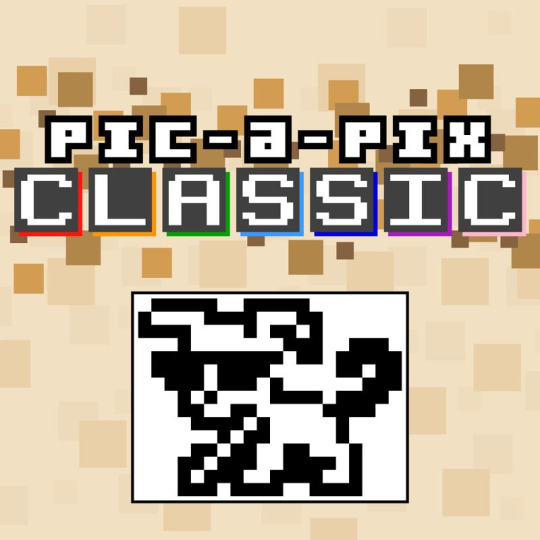
I was very pleased with this one. The presentation is nice and clean, it's very functional, and the puzzles never require guesswork. Other releases in the series are expandable with scads of add-on packs but this is just the one set of puzzles for a decent price, and there's nothing wrong with that. And check out the puzzle in the key art, it's a puppy wearing sunglasses! How can you say no to that?
2 notes
·
View notes
Text
[Review] Titan Souls (PSVita)
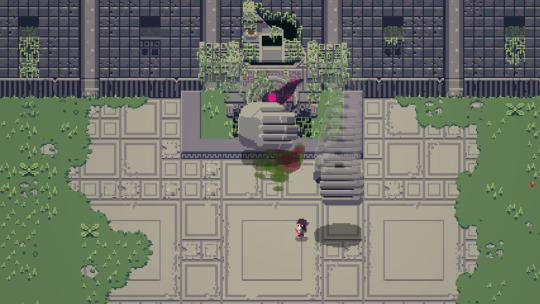
One shot, one kill.
Another game on my Vita backlog is this indie hit from 2015. It started as a Ludum Dare project by a very small British team with four bosses, and ended as an indie release under Devolver by that same team with 19 bosses and a lot more polish. It's kind of a boss rush game, Shadow of the Colossus meets Hyper Light Drifter you could say.

The theme for Ludum Dare 2014 was "You only get one", and it's expressed in Titan Souls in a few ways. Bosses only take one hit to kill; likewise you only take one hit to die. You also have only one arrow to fire from your one bow as your one means of attack (although you can then magically suck the arrow back towards you, which can be used as an alternate way to get at some bosses' weak points). It's a very clever system that's iterated on in interesting ways as you take down more of these titans.
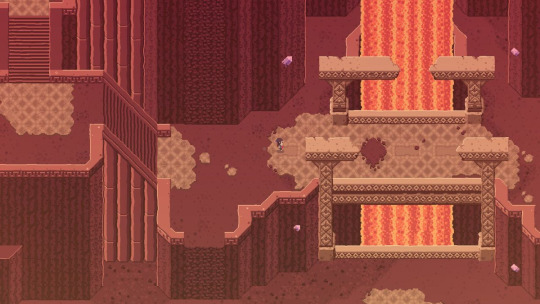
Your player character is made to feel tiny by the scale of the bosses and the world you find yourself in (along with them being drawn with so few pixels), which works very well. After the opening section you can tackle the titans in any order by roaming around the different areas, rendered in impeccable pixel art. Getting around takes a while which can be annoying if you get lost, but adds to the sense of scale and atmosphere.

The encounters feel epic and are usually over very quickly, one way or another. Unfortunately after your inevitable demise, the fade down and fade up followed by a runback to the boss arena can take a lot longer than the fight itself, which again could be an atmosphere thing but the balance weighed on the side of tedium for me. I longed for a pace closer to Super Meat Boy so I could try again quicker. Over my three hours of playtime I died over 300 times so a lot of the experience is this filler time, unless you're a speedrunner who can clear the game in twenty minutes.

The highs were high though: I enjoyed learning the boss patterns and improving my techniques, and landing that finishing blow is very satisfying. There's also an extra final boss for defeating all other bosses which actually takes three hits! Overall Titan Souls is a great expression of a simple idea executed brilliantly. The Vita might not be the best way to get the sense of scale across and the thumbstick is a bit dinky for precise aim, but it's a decent way to enjoy this lovely little game.
1 note
·
View note
Text
[Review] Severed (PSVita)

A very modern dungeon crawler for touchscreens!
I'm currently suffering through my first bout of Covid-19. It's been a miserable week so far, and one of the ways I've been getting through the days is playing portable games in bed. The Vita is so underappreciated and ticking this off my backlog helped me appreciate it all over again: the clicky buttons, thin and light form factor, and especially the large and gorgeous OLED screen. Severed is a game made for the Vita. Well, and for smartphones, 3DS, Wii U, etc... but the Vita is definitely one of the best ways to play it, probably.

Severed comes to us from the Canadian dev Drinkbox Studios. I loved both their Guacamelee games, and the art style of this is very similar: lots of bold colours, no outlines, otherworldly creature design. The atmosphere and tone here is darker though, with little humour outside of a slightly quirky NPC or two. This grim tale of a young woman in some kind of oppressive afterlife world, searching for her lost family, is a far cry from Juan and Tostada's bombastic adventures—although they do have some themes in common come to think of it—but told with just as much care and impact.

The gameplay is an interesting take on old first-person dungeon crawlers. You move between nodes or rooms, turning and stepping through them with the D-pad as you solve gate puzzles and navigate the labyrinthine structures. On the way you're frequently stopped by monsters in encounters that are preset so once you've cleared them you're free to explore and find secrets at your leisure. The minimap in the corner of the screen is so useful that I often found myself looking at it alone, and missing out on the lovely art of the main screen! It can also be expanded to plan your route which helps since there's no fast travel, but a small game world and the occasional shortcut can help if you want to backtrack.

Of course the main point of the game is the combat, which plays out via the touchscreen. Each monster type has particular ways to tackle them, and there's clear communication of their weak points, when to parry them, and so on. All this is done by swiping strategically: you can do flurries of short swipes, more damaging long swipes, and you'll gain the ability to charge or use spells to stun them or steal their buffs. Most encounters also feature multiple monsters that you have to constantly rotate between. It can be a bit overwhelming at times!

This whole mechanic is very polished and fun to engage with, although I had to step up my game later on as monster packs became more intimidating. Swiping on the responsive Vita capacitive touchscreen worked very well, although I'm partial to the precision of the Wii U's resistive touch with a stylus, so I'm sure it would be great there too. After defeating a monster is where the title mechanic comes into play (although the player character Sasha also lost her arm in the inciting attack, so it works on multiple levels).
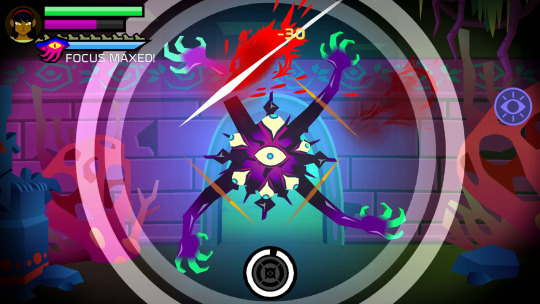
By building up a focus meter you get a brief window to sever the limbs and appendages of monsters after killing them. There's a large variety of these sourced from the bestiary of baddies, and you can then spend your stock on a skill tree. I liked expanding my abilities and trading for parts to get an edge on the next battle, I felt it was well balanced. Exploring also can net you more parts or expansions to your health and mana, and the difficulty was tuned such that these felt rewarding, even necessary, although it's also possible to just... get better at honing your swiping reflexes and responses to particular monster behaviour.
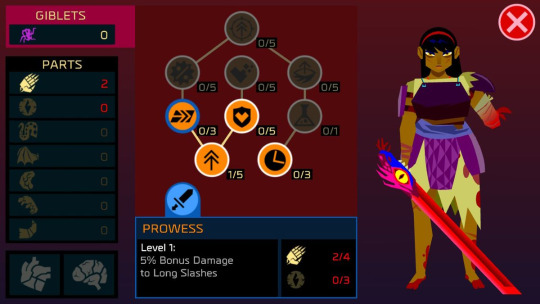
I'm glad I lifted this one out of my backlog and finally gave it a go. It's very well made, the gameplay and presentation are slick and enjoyable, and it's got that unique combination of mechanics that make it stand out. The length also seems just right, the three dungeons plus backtracking taking me about six hours. I recommend this one but only if you take breaks to rest your wrist which has to hold the console while your other hand is swiping away... the Vita might actually be the lightest platform it's available on in fact, although resting your device on a cushion is also a good option.
3 notes
·
View notes
Text
[Review] Panzer Dragoon Saga (Sat)
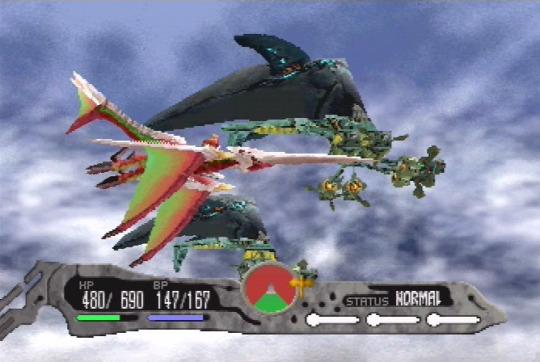
Maybe they should have stuck to rail shooters...
My perfectly sensible journey through the Panzer Dragoon series: Mini, then Orta and the OG, then Gamera 2000, Remake, Zwei, and now finally this, the one that's not actually a rail shooter. Apparently development on Zwei and Saga both started at the same time but being an RPG spread over four Saturn discs, Saga took a few more years to cook. It's also one of the more pricey games in existence due to its release right when the Saturn was imploding and overall poor sales; its reputation as a rare and expensive title comes with a vaunted hidden gem status, but the reality... well...
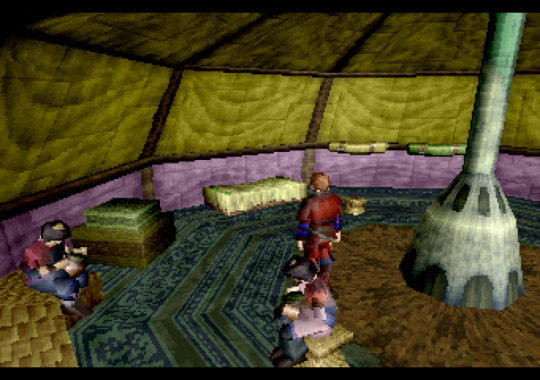
Saga (or as it's known in Japan, Azel: Panzer Dragoon RPG) certainly is experimental. Like the monsters that populate the world's wastelands and forests, it's a mutant creation, a strange hybrid of Panzer Dragoon mechanics in an RPG framework. Or if not mechanics then surface trappings: four-quadrant perspectives in battle, aiming a lock-on cursor, three-dimensional dragon flight... but the gameplay experience is nothing at all like the arcadey rail-shooters that constitute the rest of the series. Saga is very much a departure, and I don't think that works in its favour.
The world of Panzer Dragoon was always so evocative, the unknowable but hostile technology of a lost era (with its cool techno-organic designs) littering a devastated landscape, folk struggling to eke out an existence while empires battle overhead. Digging into the setting seems like something the series was crying out for... yet somehow, by nailing things down in Saga you do end up losing some of the mystique. Sure I understood the lore more clearly from in-game texts and characters pontificating, but is that what the series really needed? Maybe they explain too much, and since this is a Japanese RPG you of course end up travelling through space and time to kill God. Ho hum.

Panzer Dragoon has always had cinematic moments, but again Saga goes to excess by having all dialogue be fully voiced, with mocapped cutscenes and long conversations. (The VA is all in Japanese as well, even in the international releases, with the series' trademark made-up language only used for the intro and outro cutscenes; another choice that removes a layer of mystery from this world.) It really slows the pace down, which is a theme for the on-foot sections, battle animations, and the speed of the overall plot.
After the inciting incident where Edge the bland protag-kun meets the dragon who befriends him for no reason, almost nothing happens to advance the plot for two whole discs. Although Edge is a defined character with a voice and backstory, he was designed to take a backseat to the eponymous Azel in story terms. Congratulations Team Andromeda, you created another boring RPG protagonist. Azel herself has potential to be interesting and has her moments but ends up underdeveloped, as often a plot device as a character, and literally not present for maybe half the game.
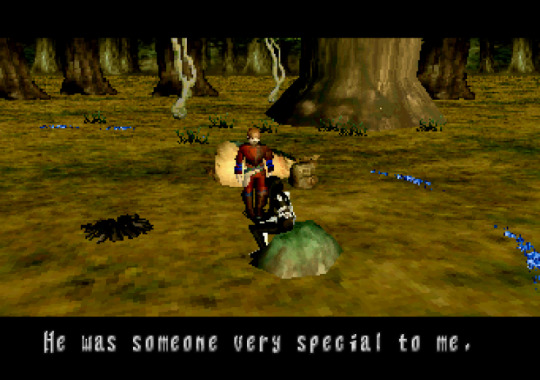
Although four discs sounds big, each one has just a handful of areas, and there's only two and a half towns in the game world. As an RPG and a story the scale is relatively small which works just fine for Panzer Dragoon, and the inhabited areas you do explore are dense and lively, with a day/night cycle and lots of interaction with the blocky Saturn people who live there. Controlling Edge in these areas is kind of clunky and slow, with the lock-on cursor being an odd way to interact and observe the world, but it results in lots of flavour text for background details even if a lot of it feels like filler.
When on the dragon, the world is understandably scaled back. An overworld map takes you between discrete zones, which are usually big open spaces broken up by tight corridors, or dungeons absolutely riddled with repetitive hallways and lifts. The dragon movement mechanics seem impressive but feel ultimately shallow and limiting, the technology and dev realities clearly not fulfilling the ambitions of open-roaming dragon-flying exploration. There's only a couple of occasions like the assault on a flying warship or the stealthy infiltration of an Imperial facility where these sections actually approach compelling gameplay; most of the time it's just busywork flying around and locking onto things to interact with them.
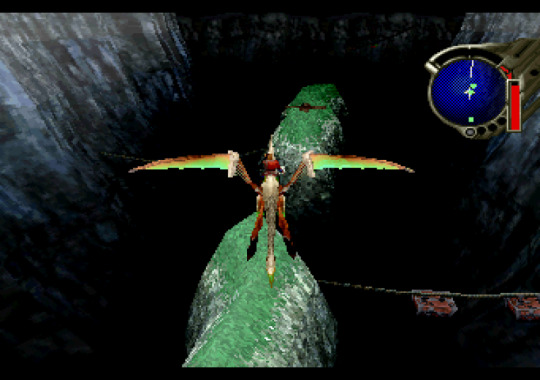
Finally, the battles. There are random and set encounters in the flying zones which take you to the battle screen, your dragon occupying one of four cardinal positions around the enemy. You or they can choose to move, which affects the ATB gauges that determine your actions but more importantly your relative positions put you in safe or danger zones from enemy attacks, and likewise enemy weak points are only revealed in certain spots. This positioning mechanic gives battles a unique feel, and turns most encounters into puzzle battles as you figure out how to respond to certain enemies. Your actions include the traditional PD single-target gun shot, a multi-target homing laser, and Zwei's Berserk technique is now the magic spell system. It's an amusing way to convert PD conventions into RPG ideas but it works well enough in theory. The problem is it felt to me that battles eventually became just slow and punishing until you learn the trick to them, at which point they're easy and time-wasting.

Saga is full of little secrets and such, the sort that compelled me to follow a guide so I didn't miss any obscure sidequest or missable treasures. One interaction requires you to talk to an NPC twenty-six times for crying out loud! Many of these rewards are relatively inconsequential but if you want your dragon to reach its final form there's a few hoops to jump through. By the end I found my inventory full of unused items and unspent money, so maybe I was too thorough. I also followed the guide's advice to seek out rare enemies to grind levels on, which may have reduced the difficulty but I'd rather that than the tedium of getting destroyed in late-game battles and having to replay sections. Saga is old-school in that way but it is from 1998 after all.

Panzer Dragoon Saga is such an unconventional RPG that I can't help but admire it, but at the same time it's clearly held back by the technology of the time and development pressures that result in it feeling messy and clumsy. There's no denying it has atmosphere and ideas and ambition, but it just didn't translate to the transcendent masterpiece that it's been built up as for me. Moreover, as a Panzer Dragoon game, it has almost nothing of what I really want out of a series that is otherwise stylish and inventive rail shooters. If telling a deeper story is what you want, then Orta was much more successful at it just by having a little more cutscene between levels! Even the rich world and visual design of the series is compromised rather than enhanced here as a result of the combination of gameplay styles/scales. I'm glad I played it but it's firmly the black sheep of the series as far as I'm concerned.
3 notes
·
View notes